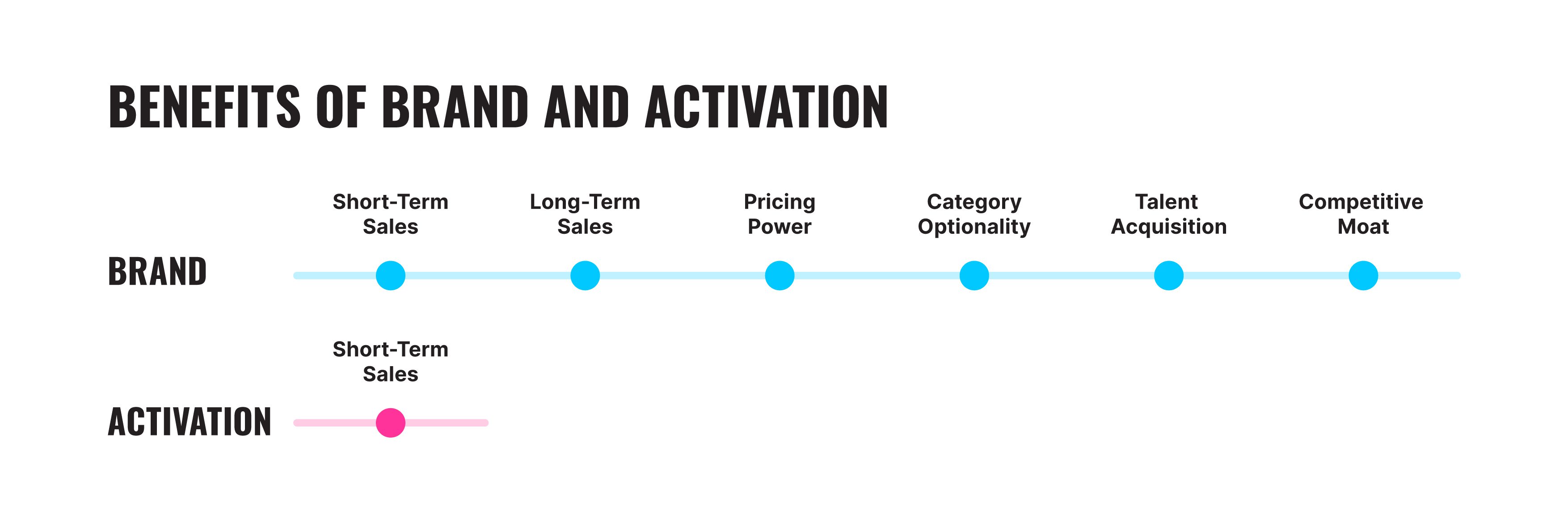The real powerhouse of lead generation
By now you should know that at Fluro, brand comes first. Get your brand right, and it will be your most powerful marketing tool, leading the way for all your campaigns and marketing activities.
If you haven’t got yourself a strong brand with distinctive assets, then you’ve got our number, right? But for now, let’s assume that you’ve got a great brand that’s working for your business. So, what comes next? Tell the world. Spread the word. Shout it from the rooftops.
Whether you call it brand awareness, brand building, or brand marketing this stage covers all the various campaigns and activities that tell the world about your brand. These days, there are more brand awareness opportunities than ever before; experiential marketing (think Carlsberg’s beer dispensing billboard) events live or virtual (think launches, keynote speeches, webinars, thought leadership), social media, PR and traditional media advertising campaigns.
The war on brand
The B2B Institute at LinkedIn, believe that there’s been a war on brand since the rise of digital marketing. The advent of tracking software and the lure of quantifiable metrics have led to an explosion in performance marketing. Being able to see actual hits, visits and clicks has become quite addictive. And let’s not forget that hard facts always impress the stakeholders. But the result of our insatiable desire for metrics, has meant that brand-building has lost its footing in many marketing budgets.
However, the B2B think tank also believes that by 2030, the tables will turn, and brand will once again reign supreme in the hearts, minds and budgets of marketing teams all over the world. They reference the game-changing research of Les Binet and Peter Field who suggest that all marketing falls into two basic categories;
- Sales Activation: performance-based tactics that work fast for short term growth
- Brand Activation: less measurable, but richer, strategic activities for long term growth
Binet and Field criticise marketing budgets that favour sales activation activities, typically called ‘lead generation’ or ‘demand generation’ in a B2B context. They believe that sales activation merely captures existing demand and brand building is the real powerhouse behind generating new demand.
The case for brand building campaigns
- Brand power builds customer loyalty and customer loyalty generates recurring revenue.
- Brand power adds value, giving a business the ability to raise prices and increase profitability amid inflation and competitive landscapes.
- Brand power can protect you against the shifting sands of category. “Categories are mortal; brands are immortal.”
- Brand power can’t be copied. Features and benefits can be copied, lead gen campaigns and tactics can be copied. But your brand is yours alone, and if someone tries to copy it, they’re breaking the law.
- Brand power attracts the best talent.

From B2B Institute; 2030 B2B Trends -Contrarian Ideas For The Next Decade
Get Creative
“Creativity is one of the most important variables in marketing success” says Jon Lombardo, of the B2B Institute. “Some would say it is the single most important variable and that strong creative can multiply the financial returns of a marketing campaign by 12X.”
And he’s not the only one who’s putting all his eggs in the creative basket. James Hurman of Previously Unavailable, has been touting the importance and extraordinary value of creativity in collaboration with WARC. WARC analysed 5,000 award-winning campaigns in their archives, from 2015 to 2022. They found that those which are highly awarded for creativity are more likely to be effective, supporting the idea that creativity supercharges the impact of marketing.
Bet Big
Getting noticed is the name of the game for marketers. And if you already have a brand that stands out, then doubling down to make a noise, is relatively easy.
But doubling down still requires a leap of faith, because it means having the guts to be different and to stand by your most distinctive qualities.
“If you’re not spending at least 50% of your budget on a single creative idea, you are not betting big enough” says the team at the B2B Institute. “When you are fortunate enough to find an idea that is contrarian and right, you need to bet big on it.”
Today, the marketing experts are recommending that budgets are split 50/50 between sales activation and brand building. If your strategy doesn’t look like this, then it’s time rethink your strategy.
Let's start something
Want to talk to us about a project?
Just get in touch, we'd love to chat.
Send an email to hello@fluroltd.com
Ring on 01628 525 449
FIND YOUR BRAVE
DISCOVER WHY BEING DIFFERENT IS MORE IMPORTANT THAN BEING BETTER WHEN IT COMES TO YOUR BRAND.
You’ve heard people talk about it. Branding experts write books about it. Business empires are built upon this single foundation; be different.
Seth Godin once said, “the sound of a small bell during a dark night is louder than the din of traffic outside your window during rush hour. Surprise and differentiation have far more impact than noise does.”
Think about it for a moment. If your unique selling point (USP) is about outperforming or undercutting the competition, chances are you won’t be able to rely on that as a competitive advantage forever. Someone else can come along at any moment and do it better than you or cheaper than you.
So, what’s the one thing they can’t compete with or do better at?
Being you; your perspective, your technique and your experience and all those intangible qualities that make your business different. And when your brand is different, you will stand out.
DIFFERENT IS BETTER
Take Apple, their agenda was not about being better than the competition. Apple was all about being different and their mission to be different informed their entire brand identity and marketing approach, changing the centre of gravity for the sector and the consumer.
Okay, so if different is good, how can you make this work for your business? It’s tempting to fall back on features and benefits when it comes to differentiating your offer, but the competition always catches up. So, let’s look beyond USPs. Instead of trying to be a better version of the competition, we’ll help you become the best version of yourself. Because after all, you’re the only one who can do it the way you can. Your unique qualities and driving purpose have meaning and value far beyond mere features and benefits.
But how do you communicate all of this personality, all the layers and complexities that form your unique character? The simple answer is branding. Branding is the key to true and lasting market differentiation. A strong, distinctive brand will give you a competitive advantage that – unlike features or benefits – can’t be copied or bettered. And unlike features and benefits, we believe that the story you tell about your brand has unlimited potential. In fact, your brand story will only become more potent over time.
WHEN IT’S HARD TO BE DIFFERENT
There are plenty of situations where it’s hard to be different. Sometimes it’s because you’re new, and you’ve got nothing to leverage. Sometimes it’s because you’re familiar and you are challenging expectations. And then there are those times when the intangibility of your offer makes it feel like you’re chasing a phantom.
– When you’re brand new
Building a memorable brand can be difficult for any new product or business. After all, how will anyone ever find you if they don’t know you exist? But that’s where marketing experts can step in and lend a hand.
The business of getting your business ‘out there’ is called Brand Awareness, and it’s a core principle in advertising. It involves first creating a memorable brand identity through design, tone of voice and customer experience and making sure your brand gets noticed and remembered through a combination of inbound and outbound marketing strategies.
– When you’re lost for words
When your offer is something new, whether it’s a product, service or business model, it makes talking about your offer a real challenge because you can’t leverage an existing ‘language’. We’ve had clients present us with an offer that doesn’t easily slot into any existing sector categories or terminology. This can make it difficult to communicate your message to the world, especially in an online context where search engine optimisation and pay-per-click (PPC) rely on keywords to communicate your offer effectively.
Coining a phrase or term for your new offer poses a problem when it comes to digital marketing and communication, because if no one is using that term, keyword or phrase in their search, then how will they find you?
– When your offer is intangible and iterative
For many start-ups there is often no physical product or service to offer, especially in the early stages of development where the ‘product’ is intellectual property. Defining immaterial goods and services makes brand identity challenging because there’s fewer opportunities to use packaging and signposting to communicate your look, feel and tone of voice.
Plus, it’s tough to define a brand when the goal posts keep changing. The nature of a start-up business often means that the brand will undergo several transformations before it gets to market. This makes it hard to know when it’s the right time to commit to a brand identity. For many start-ups, creating a strong brand identity between rounds B and C can have more impact than waiting till after the final round. Even though the parameters might change again, being armed with a strong brand identity during the funding process can project confidence and present a more concrete vision.
– When your brand is established
Loss of brand equity is usually the biggest barrier a business will have when it comes to rebranding. And we get it. A drastic change in branding has the potential to alienate existing loyal customers who have strong associations with the old brand.
That why with careful research, planning and clearly defined objectives we can protect the major brand elements to preserve recognition.
Communication is key for any successful rebrand, having an official launch and sharing the reasons behind the rebrand goes a long way towards mitigating any potential loss of brand equity. A continuous effort to monitor the impact of the rebrand will mean that we’ll be ready to adapt strategies based on feedback and market responses.
FORTUNE FAVOURS THE BRAVE
“Who Dares Wins” isn’t just a Channel 4 reality series or a John Wick tattoo and as a sentiment, it goes much further back than the British SAS. The earliest record of “Fortune Favours the Brave” or something like it, has been attributed to Roman writers in the centuries before Christ and it remains potent to this day.
Why does this phrase still have so much power?
Because it’s not easy being brave. If it was, everyone would be. Only those who overcome their fear of failure, their fear of change and challenge will win the ultimate prize of success and good fortune.
Sounds intense, doesn’t it? But in reality, being brave doesn’t start with confidence. Being brave starts with determination and courage can be learned and developed. It’s not about leaping blindly into the unknown, it’s about being observant, learning how to evaluate risk and recognise opportunity when it comes knocking.
HOW TO FIND YOUR BRAVE
We don’t expect everyone to be comfortable with our approach at first and it’s important to know that we don’t equate being brave with being foolhardy. For us, being brave is about self-awareness, understanding and great timing. To help you understand our approach, we’ve put together a list of Five Ways to Find Your Brave;
A balanced perspective
Fear can be useful. If we acknowledge our fears, we’re one step closer to overcoming them.
Identify your strengths
When you’re confident in your abilities, you’re much more willing to go all-in when an opportunity presents itself.
No risk, no reward
What’s the worst thing that could happen if you take a risk? Now compare that scenario to what will happen if you do nothing at all?
The Comfort Zone
Build your courage muscles by pushing yourself outside of your comfort zone slowly and more often. Get comfortable with feeling uncomfortable. Make peace with uncertainty.
Failure=winning
When you take a risk, you never really lose because you either succeed or you learn from your mistakes.
Being guided through the process by someone who’s done it before and has the skill to uncover and define what makes you special will make all the difference to your journey. Having a like-minded creative partner will help you build and market a brave brand. A brand so different and so strong that it will the only reason your customer chooses you.
Let's start something
Want to talk to us about a project?
Just get in touch, we'd love to chat.
Send an email to hello@fluroltd.com
Ring on 01628 525 449

